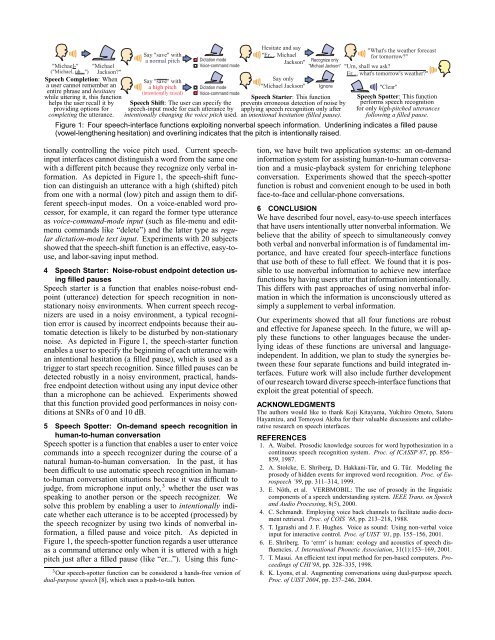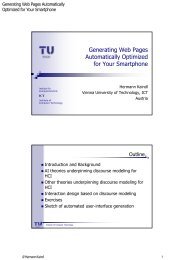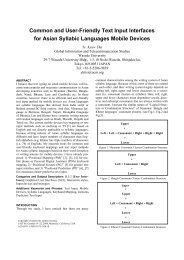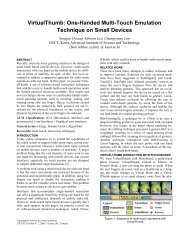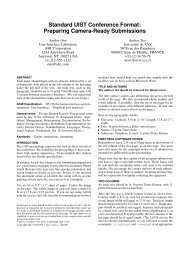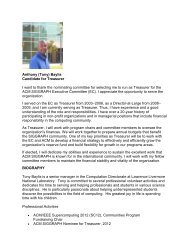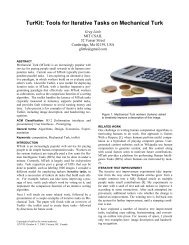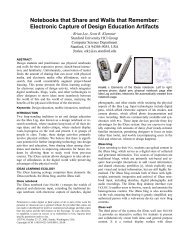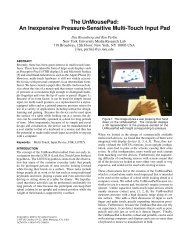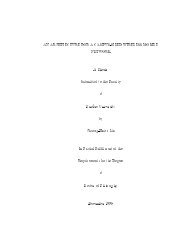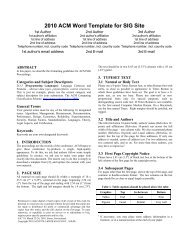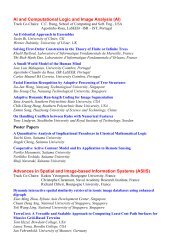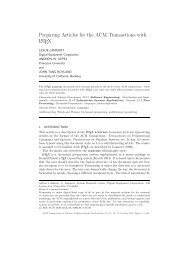Speech Interface Exploiting Intentionally-Controlled ... - ACM
Speech Interface Exploiting Intentionally-Controlled ... - ACM
Speech Interface Exploiting Intentionally-Controlled ... - ACM
Create successful ePaper yourself
Turn your PDF publications into a flip-book with our unique Google optimized e-Paper software.
"Michael-" "Michael<br />
("Michael, uh...") Jackson?"<br />
<strong>Speech</strong> Completion: When<br />
a user cannot remember an<br />
entire phrase and hesitates<br />
while uttering it, this function<br />
helps the user recall it by<br />
providing options for<br />
completing the utterance.<br />
Say "save" with<br />
a normal pitch<br />
Say "save" with<br />
a high pitch<br />
(intentionally raised)<br />
Dictation mode<br />
Voice-command mode<br />
Dictation mode<br />
Voice-command mode<br />
<strong>Speech</strong> Shift: The user can specify the<br />
speech-input mode for each utterance by<br />
intentionally changing the voice pitch used.<br />
Hesitate and say<br />
"Er..., Michael<br />
Jackson"<br />
Say only<br />
"Michael Jackson"<br />
Recognize only<br />
"Michael Jackson"<br />
Ignore<br />
<strong>Speech</strong> Starter: This function<br />
prevents erroneous detection of noise by<br />
applying speech recognition only after<br />
an intentional hesitation (filled pause).<br />
"What's the weather forecast<br />
for tomorrow?"<br />
"Um, shall we ask?<br />
Er..., what's tomorrow's weather?"<br />
"Clear"<br />
<strong>Speech</strong> Spotter: This function<br />
performs speech recognition<br />
for only high-pitched utterances<br />
following a filled pause.<br />
Figure 1: Four speech-interface functions exploiting nonverbal speech information. Underlining indicates a filled pause<br />
(vowel-lengthening hesitation) and overlining indicates that the pitch is intentionally raised.<br />
tionally controlling the voice pitch used. Current speechinput<br />
interfaces cannot distinguish a word from the same one<br />
with a different pitch because they recognize only verbal information.<br />
As depicted in Figure 1, the speech-shift function<br />
can distinguish an utterance with a high (shifted) pitch<br />
from one with a normal (low) pitch and assign them to different<br />
speech-input modes. On a voice-enabled word processor,<br />
for example, it can regard the former type utterance<br />
as voice-command-mode input (such as file-menu and editmenu<br />
commands like “delete”) and the latter type as regular<br />
dictation-mode text input. Experiments with 20 subjects<br />
showed that the speech-shift function is an effective, easy-touse,<br />
and labor-saving input method.<br />
4 <strong>Speech</strong> Starter: Noise-robust endpoint detection using<br />
filled pauses<br />
<strong>Speech</strong> starter is a function that enables noise-robust endpoint<br />
(utterance) detection for speech recognition in nonstationary<br />
noisy environments. When current speech recognizers<br />
are used in a noisy environment, a typical recognition<br />
error is caused by incorrect endpoints because their automatic<br />
detection is likely to be disturbed by non-stationary<br />
noise. As depicted in Figure 1, the speech-starter function<br />
enables a user to specify the beginning of each utterance with<br />
an intentional hesitation (a filled pause), which is used as a<br />
trigger to start speech recognition. Since filled pauses can be<br />
detected robustly in a noisy environment, practical, handsfree<br />
endpoint detection without using any input device other<br />
than a microphone can be achieved. Experiments showed<br />
that this function provided good performances in noisy conditions<br />
at SNRs of 0 and 10 dB.<br />
5 <strong>Speech</strong> Spotter: On-demand speech recognition in<br />
human-to-human conversation<br />
<strong>Speech</strong> spotter is a function that enables a user to enter voice<br />
commands into a speech recognizer during the course of a<br />
natural human-to-human conversation. In the past, it has<br />
been difficult to use automatic speech recognition in humanto-human<br />
conversation situations because it was difficult to<br />
judge, from microphone input only, 3 whether the user was<br />
speaking to another person or the speech recognizer. We<br />
solve this problem by enabling a user to intentionally indicate<br />
whether each utterance is to be accepted (processed) by<br />
the speech recognizer by using two kinds of nonverbal information,<br />
a filled pause and voice pitch. As depicted in<br />
Figure 1, the speech-spotter function regards a user utterance<br />
as a command utterance only when it is uttered with a high<br />
pitch just after a filled pause (like “er...”). Using this func-<br />
3 Our speech-spotter function can be considered a hands-free version of<br />
dual-purpose speech [8], which uses a push-to-talk button.<br />
tion, we have built two application systems: an on-demand<br />
information system for assisting human-to-human conversation<br />
and a music-playback system for enriching telephone<br />
conversation. Experiments showed that the speech-spotter<br />
function is robust and convenient enough to be used in both<br />
face-to-face and cellular-phone conversations.<br />
6 CONCLUSION<br />
We have described four novel, easy-to-use speech interfaces<br />
that have users intentionally utter nonverbal information. We<br />
believe that the ability of speech to simultaneously convey<br />
both verbal and nonverbal information is of fundamental importance,<br />
and have created four speech-interface functions<br />
that use both of these to full effect. We found that it is possible<br />
to use nonverbal information to achieve new interface<br />
functions by having users utter that information intentionally.<br />
This differs with past approaches of using nonverbal information<br />
in which the information is unconsciously uttered as<br />
simply a supplement to verbal information.<br />
Our experiments showed that all four functions are robust<br />
and effective for Japanese speech. In the future, we will apply<br />
these functions to other languages because the underlying<br />
ideas of these functions are universal and languageindependent.<br />
In addition, we plan to study the synergies between<br />
these four separate functions and build integrated interfaces.<br />
Future work will also include further development<br />
of our research toward diverse speech-interface functions that<br />
exploit the great potential of speech.<br />
ACKNOWLEDGMENTS<br />
The authors would like to thank Koji Kitayama, Yukihiro Omoto, Satoru<br />
Hayamizu, and Tomoyosi Akiba for their valuable discussions and collaborative<br />
research on speech interfaces.<br />
REFERENCES<br />
1. A. Waibel. Prosodic knowledge sources for word hypothesization in a<br />
continuous speech recognition system. Proc. of ICASSP 87, pp. 856–<br />
859, 1987.<br />
2. A. Stolcke, E. Shriberg, D. Hakkani-Tür, and G. Tür. Modeling the<br />
prosody of hidden events for improved word recognition. Proc. of Eurospeech<br />
’99, pp. 311–314, 1999.<br />
3. E. Nöth, et al. VERBMOBIL: The use of prosody in the linguistic<br />
components of a speech understanding system. IEEE Trans. on <strong>Speech</strong><br />
and Audio Processing, 8(5), 2000.<br />
4. C. Schmandt. Employing voice back channels to facilitate audio document<br />
retrieval. Proc. of COIS ’88, pp. 213–218, 1988.<br />
5. T. Igarashi and J. F. Hughes. Voice as sound: Using non-verbal voice<br />
input for interactive control. Proc. of UIST ’01, pp. 155–156, 2001.<br />
6. E. Shriberg. To ‘errrr’ is human: ecology and acoustics of speech disfluencies.<br />
J. International Phonetic Association, 31(1):153–169, 2001.<br />
7. T. Masui. An efficient text input method for pen-based computers. Proceedings<br />
of CHI’98, pp. 328–335, 1998.<br />
8. K. Lyons, et al. Augmenting conversations using dual-purpose speech.<br />
Proc. of UIST 2004, pp. 237–246, 2004.


